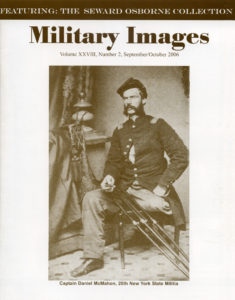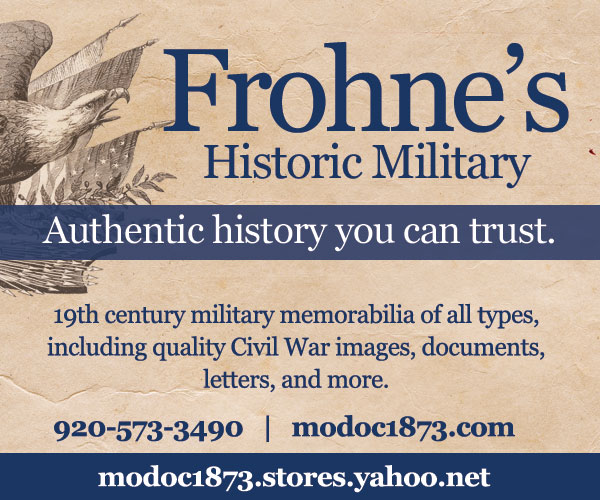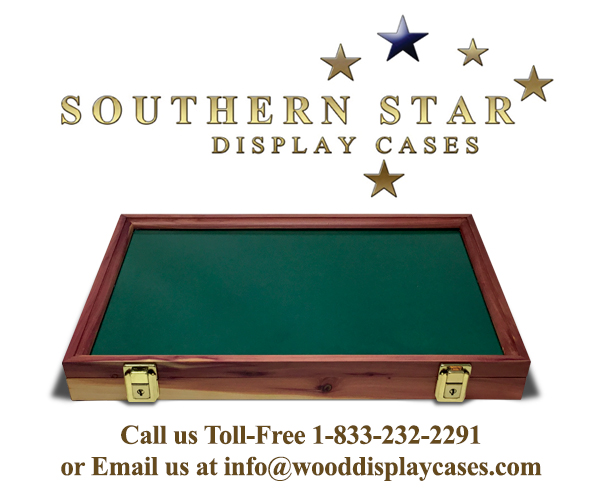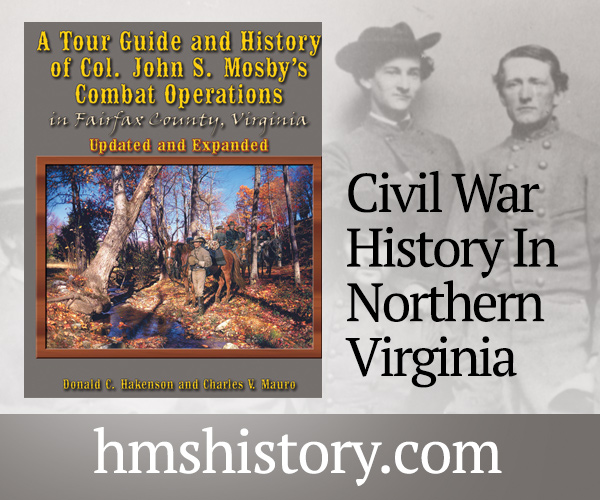The complete issue
Vol. XXVIII, No. 2
(40 pages)
Print edition: Visit our store to check availability
Digital edition: Visit JSTOR.org to purchase
Subscribe to MI
Explore the MI Archives: Browse | Advanced search | Tutorial
Inside
Cover image
A carte de visite from the Seward Osborne collection is a portrait of Capt. Daniel McMahon of the 20th New York State Militia. He is posed here minus his left leg, which was amputated as the result of a seriously wound suffered on July 1, 1863, during the Battle of Gettysburg.
Table of Contents (p. 1)
Editor’s Desk (p. 2)
The editor introduces the cover story, a gallery of images from longtime collector and historian Seward Osborne. Also mentioned is Jack Ringwalt, who lost a six-year battle with cancer. The second of Ringwalt’s two-part story about regular army soldier Robert Crispin appears in this issue.
Passing in Review (pp. 3-4)
Two books are recommended: Disgrace at Gettysburg, The Arrest and Court-Martial of Brigadier General Thomas A. Rowley, USA (McFarland & Company, Inc.) by John F. Krumwiede and A History of the 4th Wisconsin Infantry and Cavalry in the Civil War (Savas Beatie LLC) by Michael J. Martin.
Images From The Seward Osborne Collection (pp. 5-21)
The introduction to this gallery of primarily New York soldiers notes, “Seward Osborne’s name is synonymous with fine Civil War photographs. In this photo survey Seward shares with us some gems from his extensive collection.” An interview with Osborne is followed by 57 images. Identified soldiers from the 20th New York State Militia include Hugh Donihuem Nicholas Hoysradt, Thomas Joseph Leahey, John McEntee, Daniel McMahon, James Pierce George Henry Sharpe, Joseph S. Schepmoes, Abram Sharpe Smith, William Vallet and Reuben Van Leuven. Identified soldiers from the 120th New York Infantry include Barnet Bishop, Peter Merritt, Levi Rosa and George Sharpe. Identified soldiers from the 156th New York Infantry include Philip Decker, Johannes Lefavre, Peter LeFavre, Charles Morrison, Jacob Sharpe and Isaac L. Singer. Identified soldiers from other regiments, state and federal military departments include William H. Harris of the U.S. Ordnance Department, U.S. Military Academy Cadet Jared L. Rathbone, New York Quartermaster General and future U.S. President Chester Alan Arthur, New York State Adjutant Gen. John T. Sprague, U.S. Adjutant Gen. Lorenzo Thomas with Brig. Gen. Alexander Asboth and others, Brig. Gen. James Sidney Robinson, Maj. Gen. George Sears Greene, John T. Wilder of the 17th Indiana Mounted Infantry, John S. Rosa of the 2nd Kansas Cavalry, George W. Elwell of the 35th New York Infantry, Joseph Auguste Fontaine of the 55th New York Infantry, William Patton Halsted of the 65th New York Infantry, William H. Male of the 139th New York Infantry, George Young of the 143rd New York Infantry and Frederick Stephen Wallace of the 61st Ohio Infantry. Lastly, Fox, the mascot of the 61st Ohio Infantry, is also included.
Uniforms & History by Michael J. McAfee (pp. 22-25)
In “The Twentieth Regiment, New York State Militia, 1861 ‘Ulster Guard’,” McAfee profiles one of the Empire State’s best-known militia units. The profile is illustrated with two image of the shako worn by members of the regiment and five soldier images, including lieutenants John D. Cook and Charles S. Wilkinson, and Col. George W. Pratt.
Our Scout: The Sequel by Jack Ringwalt (pp. 26-35)
Described as “The final word on one man’s search for the ‘real’ Robert Crispin, the author traces his interest in Crispin back to 1992 and how he engaged individuals along the way to reconstruct the subject’s military service in the West after the Civil War. Ringwalt goes on to record in detail the numerous watershed moments along his journey that include the acquisition of a tomahawk from Crispin’s descendants.
Stragglers (p. 36)
Three identified soldiers include Bugler James P. Campbell of the 1st Oregon Infantry, a post-war image of Col. Richard Henry Pratt when he served as superintendent of the Carlisle Indian School and a post-war image of former Confederate Joseph Wheeler as a Union brigadier general.
The Confederate Soldier (p. 37)
Quarter-plate ambrotype pictures an unidentified Alabama cavalry officer. The provenance of the image is Pell City, Ala.
Sutler’s Row (p. 38)
Back Cover Story (p. 39)
The Last Shot (p. 40)
A hard-plate image from the Roy Mantle collection is a portrait of a Confederate soldier armed with an Enfield rifle, Bowie Knife and revolver.
Back Cover
An albumen photograph from the Seward Osborne collection pictures Pvt. Philip Elmendorf of the 120th New York Infantry, posed with horses that belonged to the regiment’s colonel, George Henry Sharpe.





































